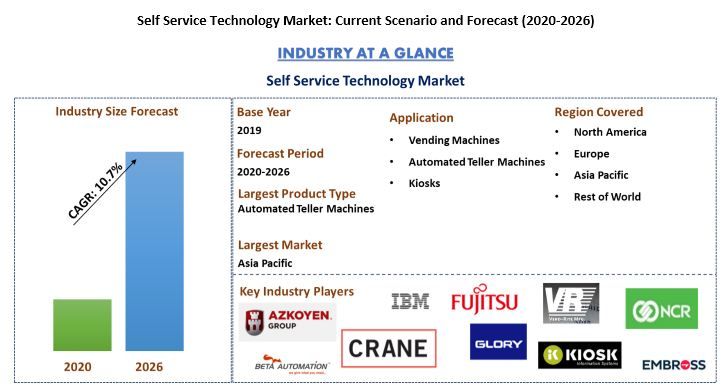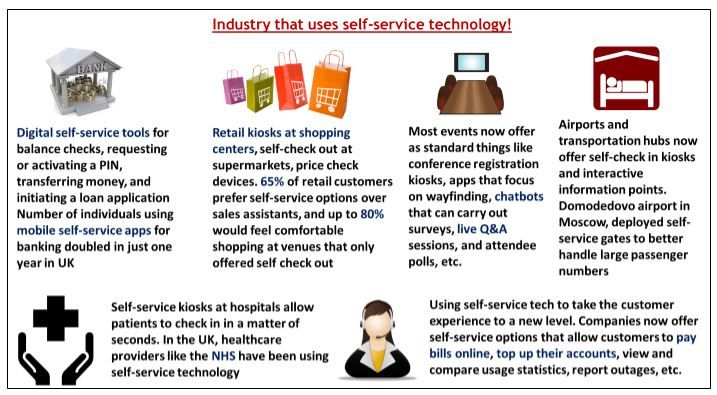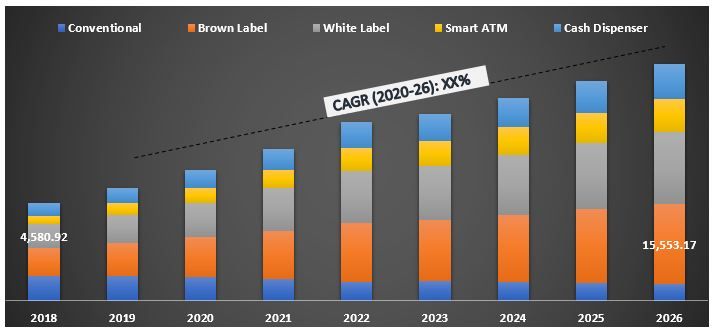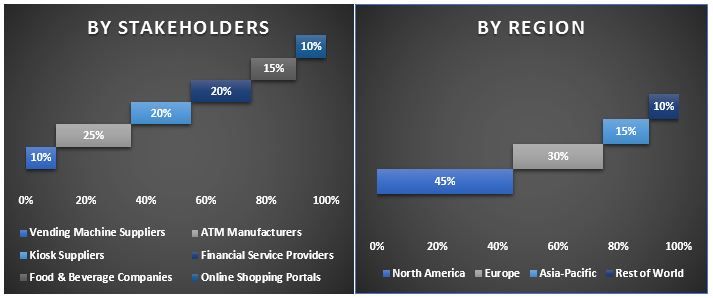- Accueil
- À propos de nous
- Industrie
- Services
- Lecture
- Contactez-nous
Marché des technologies libre-service : scénario actuel et prévisions (2020-2026)
Accent mis sur le type de produit (distributeur automatique, guichet automatique bancaire, kiosques), le type de distributeur automatique (boissons, bonbons, collations, gommes à mâcher, cigarettes), le type de GAB (conventionnel, label marron, label blanc, GAB intelligent, distributeur de billets), le type de kiosques (photo, DVD, billetterie, RH et emploi, service autonome aux patients, fourniture d'informations, services bancaires et financiers, spécialisés), le type de solution (déploiement, services gérés) et la région/le pays
Le marché mondial de la technologie de libre-service a généré un chiffre d'affaires de 26,56 milliards de dollars US en 2019 et devrait croître à un TCAC de 10,7 % au cours de la période de prévision 2020-2026, pour atteindre une taille de marché de 56,8 milliards de dollars US d'ici 2026. Le monde trépidant d'aujourd'hui se caractérise de plus en plus par des transactions facilitées par la technologie. Aujourd'hui, les clients préfèrent interagir avec la technologie pour créer des résultats de service au lieu d'interagir avec un fournisseur de services. Avec la croissance rapide des technologies, diverses innovations sont introduites afin de faciliter les besoins et les nécessités des personnes. L'une des innovations qui a recueilli une grande popularité auprès des clients est la technologie de libre-service (TLS). Les technologies de libre-service (TLS) sont des interfaces technologiques qui permettent aux clients de produire un service indépendamment de l'implication directe des employés du service. Les principales technologies de libre-service comprennent les guichets automatiques bancaires (GAB), le départ automatique des hôtels, les services bancaires par téléphone et les services sur Internet, tels que le suivi des colis Federal Express et les services de courtage en ligne. De plus, la transformation numérique a considérablement modifié l'interaction entre l'entreprise, les clients et les offres de services. Les développements technologiques tels que les smartphones et l'IoT ont également fait augmenter le besoin de satisfaction instantanée chez les consommateurs. Au fil du temps, la technologie de libre-service est passée d'un moyen alternatif de gérer certaines tâches à un canal principal compte tenu des avantages qu'elle comporte. Certains des avantages associés aux technologies de libre-service sont énoncés ci-dessous :
- Commodité, à la fois pour l'utilisateur et pour le fournisseur de services : les changements de style de vie qui ont commencé au cours de la seconde moitié du XXe siècle signifient que les clients sont devenus plus occupés que jamais et que le temps est considéré comme un atout précieux, donc tout ce qui permet de gagner du temps est considéré comme un ajout bienvenu.
- L'importance croissante de la prestation d'expériences : les fournisseurs de services considèrent la technologie de libre-service comme une opportunité d'améliorer les niveaux de satisfaction de la clientèle (et donc de fidélisation) en l'utilisant pour créer des produits et des services axés sur l'expérience.
- Rentable : la technologie de libre-service est judicieuse sur le plan économique compte tenu du coût inférieur des interactions en ligne par rapport au personnel de première ligne.
- Évolution démographique : la génération du millénaire et les autres natifs du numérique se sentent à l'aise avec la technologie de libre-service.
- Évolution des attentes des consommateurs : de nos jours, la plupart des consommateurs préfèrent une expérience pratique et une approche plus interactive de la technologie qui offre commodité et transactions rapides.
- La technologie de libre-service reflète la culture 24h/24 et 7j/7 dans laquelle nous vivons maintenant, l'évolution de la technologie de libre-service est presque une conséquence naturelle des récents changements dans la société et dans le monde des affaires.
De nombreux fournisseurs de services utilisent un large éventail de technologies pour permettre aux clients de consommer des services ou des produits électroniquement sans contact direct. Les technologies de libre-service étant importantes dans les services bancaires et financiers, de la même manière, les restaurants de restauration ont également introduit des technologies de libre-service principalement sous la forme de tablettes informatiques afin de permettre aux consommateurs de passer des commandes et de payer des factures. Les technologies de libre-service se retrouvent également dans l'industrie du tourisme et de l'hôtellerie, notamment les distributeurs automatiques de billets d'avion, les guichets automatiques bancaires et les services de réservation informatisés. D'autres exemples de TLS dans l'industrie du tourisme et de l'hôtellerie incluent également les distributeurs automatiques de billets (TVM) pour le transport ferroviaire, l'application mobile pour réserver des chambres d'hôtel telles que Trivago, Agoda.com et Booking.com, l'application de navigation telle que WAZE pour les directions, les bornes d'enregistrement dans les hôtels, les bornes de libre-service pour la commande de nourriture et les bornes d'information en libre-service que l'on trouve généralement dans un centre commercial. De plus, dans le secteur de la vente au détail, des sondages montrent que plus de 65 % des clients de la vente au détail préfèrent les options de libre-service aux vendeurs, tandis que d'autres études suggèrent que jusqu'à 80 % des acheteurs interrogés préféreraient faire leurs achats dans des lieux qui n'offrent que le libre-service. Il a été prévu, selon le sondage, que plus de 85 % des entreprises s'attendent à ce que le libre-service soit le canal à la croissance la plus rapide dans le service à la clientèle d'ici 2021 à travers le monde. Cependant, le manque de compréhension englobe le principal obstacle qui entrave la tendance florissante des technologies de libre-service. Par exemple, dans le scénario actuel, les consommateurs connectés ont de grandes attentes envers les marques avec lesquelles ils traitent. Il a été constaté que plus de la moitié, soit 53 %, des adultes américains sont susceptibles d'abandonner un achat en ligne s'ils ne trouvent pas de réponse rapide à leur question. De plus, environ 45 % des consommateurs ont déclaré qu'ils passeraient seulement 5 minutes à chercher des informations sur le site Web d'une entreprise avant d'abandonner et d'aller ailleurs.
« Le segment des GAB a dominé le marché mondial de la technologie de libre-service, avec une part de 82,2 % en 2019 »
Selon la catégorie de produits, le marché mondial de la technologie de libre-service est segmenté en distributeurs automatiques, GAB et bornes. En 2019, le segment des GAB a dominé le marché et devrait maintenir sa domination tout au long de la période de prévision 2020-2026. Cependant, le segment des bornes devrait connaître la croissance du TCAC la plus élevée, soit 14,1 % au cours de la période analysée. Ces interactions technologiques devraient devenir un critère clé de réussite commerciale à long terme.
« Le chiffre d'affaires des distributeurs automatiques de boissons a généré 943,41 millions de dollars US en 2019 »
La catégorie de produits des distributeurs automatiques est en outre divisée en distributeurs automatiques de boissons, de bonbons, de collations, de gommes à mâcher, de cigarettes et de produits spécialisés. Le chiffre d'affaires des distributeurs automatiques de bonbons devrait s'élever à 991,59 millions de dollars US d'ici 2026. Les distributeurs automatiques de produits spécialisés devraient connaître une croissance du TCAC de 11,5 % au cours de la période de prévision.
« Les GAB de marque marron ont dominé le segment des GAB du marché mondial de la technologie de libre-service en 2019 »
Le segment mondial des GAB de libre-service est en outre divisé en GAB conventionnels, de marque marron, de marque blanche, intelligents et distributeurs automatiques de billets. En 2019, les GAB de marque marron ont généré un chiffre d'affaires de 6 447,24 millions de dollars US et devraient croître à un TCAC de 12,3 % au cours de la période analysée. Le segment des GAB intelligents devrait connaître la croissance du TCAC la plus élevée, soit 14,8 % au cours de la période de prévision 2020-2026.
Marché des GAB, par type de GAB, mondial 2018-2026 (en milliards de dollars US)
« Les bornes de billetterie ont dominé le segment du marché des bornes de libre-service, représentant une part de 40,7 % en 2019 »
Selon la catégorie de produits des bornes, le marché est divisé en bornes de photos, de DVD, de billetterie, de RH et d'emploi, de libre-service aux patients, de fourniture d'informations et de bornes bancaires et financières. Le segment du libre-service aux patients devrait générer un chiffre d'affaires de 354,59 millions de dollars US d'ici 2026. Le segment des bornes bancaires et financières devrait connaître le TCAC le plus élevé, soit 16,5 % au cours de la période de prévision.
« L'Asie-Pacifique a dominé le marché mondial de la technologie de libre-service en 2019 »
Pour une analyse approfondie de l'industrie, une analyse détaillée au niveau des pays est effectuée pour les principales régions/pays, notamment l'Amérique du Nord (États-Unis, Canada, reste de l'Amérique du Nord), l'Europe (Russie, Allemagne, Royaume-Uni, France, Espagne, Italie, reste de l'Europe), l'Asie-Pacifique (Chine, Japon, Inde, Corée du Sud, Singapour, Malaisie, reste de l'Asie-Pacifique) et le reste du monde. L'Asie-Pacifique a généré un chiffre d'affaires de 9 726,81 millions de dollars US en 2018 et devrait connaître une croissance du TCAC de 12,0 % au cours de la période de prévision 2020-2026. L'augmentation de la population urbaine, associée à la demande de technologies permettant de gagner du temps dans des pays tels que l'Inde, la Chine et d'autres pays asiatiques émergents, aiderait la région à rester dominante au cours de la période de prévision.
Paysage concurrentiel : les 10 principaux acteurs du marché
Azkoyen Group, Kiosk Information System, Crane Corp, Fujitsu, IBM, Glory Ltd, Vendrite, Embross, NCR Corporation, Beta Automations sont quelques-uns des principaux acteurs opérant dans l'industrie de la technologie de libre-service. Plusieurs fusions et acquisitions ainsi que des partenariats ont été entrepris par ces acteurs pour faciliter l'accès des clients à des produits de haute technologie et innovants.
Raisons d'acheter :
- Taille actuelle et future du marché de 2020 à 2026 en termes de valeur (en dollars US)
- Analyse combinée d'une recherche secondaire approfondie et de la contribution de la recherche primaire par l'entremise des principaux leaders d'opinion de l'industrie.
- Détails au niveau des pays de la consommation globale de la technologie de libre-service
- Un aperçu rapide du rendement global de l'industrie
- Analyse approfondie des principaux acteurs de l'industrie
- Analyse détaillée du scénario d'exportation et d'importation de l'industrie
- Une analyse détaillée du cadre réglementaire, des moteurs, des contraintes, des principales tendances et des opportunités qui prévalent dans l'industrie
- Examen de l'attractivité de l'industrie à l'aide de l'analyse des cinq forces de Porter et des jeunes entreprises
- L'étude couvre de manière exhaustive le marché à travers différents segments et sous-segments du marché.
- Région/pays couvert(s) : Amérique du Nord (États-Unis, Canada, reste de l'Amérique du Nord), Europe (Russie, Allemagne, Royaume-Uni, France, Espagne, Italie, reste de l'Europe), Asie-Pacifique (Chine, Japon, Inde, Corée du Sud, Singapour, Malaisie, reste de l'Asie-Pacifique) et reste du monde
Options de personnalisation :
UMI comprend que vous pouvez avoir vos propres besoins commerciaux, c'est pourquoi nous offrons également des solutions entièrement personnalisées aux clients. Le marché mondial de la technologie de libre-service peut être personnalisé au niveau du pays ou à tout autre segment de marché.
Table des matières
L'analyse du marché historique, l'estimation du marché actuel et la prévision du marché futur pour la technologie de libre-service ont été les trois principales étapes entreprises pour créer et analyser la tendance d'adoption de la technologie de libre-service dans divers secteurs verticaux dans les principales régions/pays du monde. Des recherches secondaires exhaustives ont été menées pour collecter la taille du marché historique afin d'estimer le marché actuel de la technologie. Deuxièmement, pour valider ces informations, de nombreuses conclusions et hypothèses ont été prises en considération. De plus, des entretiens primaires exhaustifs ont été menés avec des experts de l'industrie à travers la chaîne de valeur du secteur de la technologie de libre-service. Après l'hypothèse et la validation des chiffres du marché grâce à des entretiens primaires, une approche ascendante a été utilisée pour prévoir la taille complète du marché de la technologie. Par la suite, des méthodes de ventilation du marché et de triangulation des données ont été adoptées pour estimer et analyser la taille du marché des segments et sous-segments auxquels appartient l'industrie. La méthodologie détaillée est expliquée ci-dessous :
Analyse de la taille du marché historique
Étape 1 : Étude approfondie des sources secondaires :
Une étude secondaire détaillée a été menée pour obtenir la taille du marché historique de la technologie de libre-service grâce à des sources internes à l'entreprise telles que les rapports annuels et les états financiers, les présentations de performance, les communiqués de presse, etc., et les sources externes, y compris les revues, les actualités et les articles, les publications gouvernementales, les publications des concurrents, les rapports sectoriels, les bases de données tierces et d'autres publications crédibles. Pour la collecte de données économiques, des sources telles que Trading Economics, Trade Map, World Bank, IMF, FAO entre autres ont été utilisées.
Étape 2 : Segmentation du marché :
Après avoir obtenu la taille du marché historique de la technologie de libre-service, une analyse secondaire détaillée a été menée pour recueillir des informations sur le marché historique et la part des différents segments et sous-segments pour les principales régions/pays du monde. Le rapport segmente le marché mondial de la technologie de libre-service en fonction de la catégorie de produits, du type de produits et du type de solution. L'analyse plus approfondie au niveau des pays a été menée pour analyser l'adoption et la pénétration globales de la technologie dans ce pays particulier.
Étape 3 : Analyse des facteurs :
Après avoir acquis la taille du marché historique des différents segments et sous-segments, une analyse des facteurs détaillée a été menée pour estimer la taille actuelle du marché de la technologie de libre-service. L'analyse des facteurs a été menée à l'aide de variables dépendantes et indépendantes telles qu'une demande accrue de commodité et de facilité, une sensibilisation croissante aux progrès technologiques, l'évolution des modes de vie et le développement économique rapide. Le scénario de l'offre et de la demande a également été étudié en profondeur en tenant compte des principaux partenariats, des fusions et acquisitions, de l'expansion des activités, des lancements de produits et en analysant la liste des start-ups dans le secteur de la technologie de libre-service à travers le monde.
Estimation et prévision de la taille actuelle du marché
Taille actuelle du marché : Sur la base des informations exploitables tirées des 3 étapes ci-dessus, nous sommes parvenus à la taille actuelle du marché, aux principaux acteurs du marché de la technologie de libre-service et aux parts de marché de ces acteurs. Toutes les répartitions des parts de pourcentage requises et les ventilations du marché ont été déterminées à l'aide de l'approche secondaire susmentionnée et ont été vérifiées par le biais d'entretiens primaires.
Estimation et prévision : Pour l'estimation et la prévision du marché, des pondérations ont été attribuées à différents facteurs, y compris les moteurs et les tendances, les contraintes et les opportunités disponibles pour les parties prenantes. Après avoir analysé ces facteurs, les techniques de prévision pertinentes, c'est-à-dire l'approche ascendante, ont été appliquées pour parvenir à la prévision du marché relative à 2026 pour différents segments et sous-segments dans les principales régions/pays du monde. La méthodologie de recherche adoptée pour estimer la taille du marché comprend :
- La taille du marché de l'industrie, en termes de valeur (US$) et le taux d'adoption de la technologie de libre-service dans les principales régions/pays
- Toutes les parts de pourcentage, les répartitions et les ventilations des segments et sous-segments du marché
- Les principaux acteurs du marché de la technologie de libre-service en termes de services offerts ainsi que de part de marché. De plus, les stratégies de croissance adoptées par ces acteurs pour concurrencer sur le marché en croissance rapide
Validation de la taille et de la part du marché
Recherche primaire : Des entretiens approfondis ont été menés avec les principaux leaders d'opinion (KOL), y compris les cadres supérieurs (CXO/VP, chef des ventes, chef du marketing, chef des opérations et chef régional, chef de pays, etc.) dans les principales régions/pays. Les résultats de la recherche primaire ont ensuite été résumés et une analyse statistique a été effectuée pour prouver l'hypothèse énoncée. Les informations issues de la recherche primaire ont été regroupées avec les résultats secondaires, transformant ainsi les informations en informations exploitables.
Répartition des participants primaires dans différentes régions
Ingénierie du marché
La technique de triangulation des données a été utilisée pour compléter l'estimation globale du marché et pour parvenir à des chiffres statistiques précis pour chaque segment et sous-segment liés au marché de la technologie de libre-service à l'échelle mondiale. Les données ont été divisées en plusieurs segments et sous-segments après avoir étudié divers paramètres et tendances dans les domaines de la catégorie de produits, du type de produits et du type de solution de la technologie de libre-service.
Objectif principal de l'étude de marché sur la technologie de libre-service
Les tendances actuelles et futures du marché de la technologie de libre-service sont mises en évidence dans l'étude. Les investisseurs peuvent obtenir des informations stratégiques pour fonder leur discrétion en matière d'investissements à partir de l'analyse qualitative et quantitative réalisée dans l'étude. Les tendances actuelles et futures du marché ont déterminé l'attractivité globale du marché au niveau régional/national, offrant ainsi une plateforme au participant industriel pour exploiter le marché inexploité afin de bénéficier d'un avantage de premier entrant. Les autres objectifs quantitatifs des études comprennent :
- Analyser la taille actuelle et prévue du marché de la technologie de libre-service en termes de valeur (US$). De plus, analyser la taille actuelle et prévue du marché des différents segments et sous-segments
- Les segments de l'étude comprennent la catégorie de produits, le type de produits, le type de solution
- Définir et analyser le cadre réglementaire de la technologie de libre-service
- Analyser la chaîne de valeur impliquée avec la présence de divers intermédiaires, ainsi qu'analyser les comportements des clients et des concurrents liés à l'industrie
- Analyser la taille actuelle et prévue du marché du marché de la technologie de libre-service pour les principales régions/pays, notamment l'Amérique du Nord (États-Unis, Canada, reste de l'Amérique du Nord), l'Europe (Russie, Allemagne, Royaume-Uni, France, Espagne, Italie, reste de l'Europe), l'Asie-Pacifique (Chine, Japon, Inde, Corée du Sud, Singapour, Malaisie, Rets de l'Asie-Pacifique) et le reste du monde
- Définir et analyser le paysage concurrentiel de la technologie de libre-service et les stratégies de croissance adoptées par les acteurs du marché pour se maintenir sur le marché en croissance rapide
- Étudier en profondeur le scénario d'exportation et d'importation de l'industrie
Connexes Rapports
Les clients qui ont acheté cet article ont également acheté














